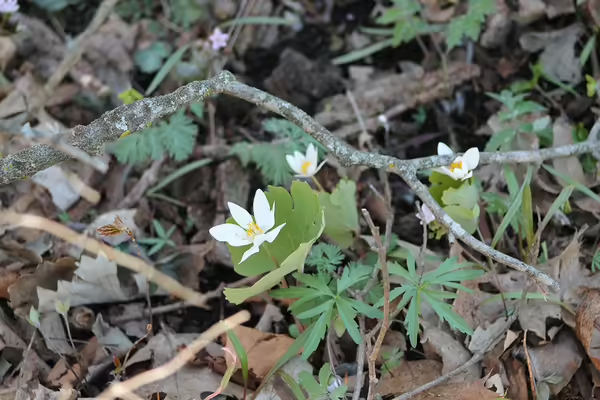
URBANA, Ill. – Spring ephemeral flowers are nature’s gems after winter. These short-lived beauties are wildflowers that grow in woodlands in the early spring before the leaves on deciduous trees are open. They are called spring ephemerals because they have a relatively short blooming time.
University of Illinois Extension Horticulture Educator Gemini Bhalsod says these seasonal plants grow, flower, and set seed relatively quickly.
“They are usually dormant by mid-summer when the leaves die back again,” Bhalsod says. “In your garden one moment and gone another.”
Spring ephemerals complete most of their life cycle in the early spring before the trees and understory shrubs leaf out and take over most of the available light. These plants start growing roots in the fall and winter, to fully emerge above ground in the spring. This time of year is a tough time to be a growing plant – soil temperatures are low, the weather is unpredictable, and there are just a few pollinators foraging.
As temperatures increase and sunlight becomes less available in the late spring and summer, growth slows down, nutrients are stored underground, and the plants begin to die back.
“There is some conflicting information and opinions out there as to whether spring ephemerals are just a special type of spring flower or if they are a spring bulb,” Bhalsod says.
One major difference, with a few exceptions, is that ephemeral foliage dies back in the early summer while the foliage of spring bulbs lasts longer.
With the right location, gardeners can grow spring ephemerals in their yards. Since a lot of spring ephemerals can be slow to grow and spread, plant them in groups to have a sense of fullness.
Plant in high organic matter areas that mimic a woodland; no fertilizer is needed. Water only during establishment or in times of drought. Leaf die back is normal.
Many nurseries sell spring ephemerals these days due to their increased popularity. Planting seeds can be a less expensive, but slower approach and you’ll have to break the dormancy of the seed before it grows. Nurseries sell potted plants in the spring and fall. If it’s a little later in the spring, the above ground portion of the plant might look yellow, but the root mass is still alive.
“Never collect plants in the wild as it is illegal, and can really disrupt natural habitat,” Bhalsod says.
Plants bought online that are mailed, they will likely be dormant with bare roots. There will be no top growth and they are usually packed in moist packing material. Plant them right away.
Skunk Cabbage, Symplocarpus foetidus, is one of the earliest spring ephemerals that emerges in February. There are tiny yellow flowers held on a spadix inside of a purple flower. The plant attracts carrion flies as pollinators. After it flowers, large smooth cabbage-like leaves develop.
Dutchman’s Breeches, Dicentra cucullaria, is a distinct plant that flowers in April. It gets its common name because the individual blossoms resemble pants, or ‘breeches.’ Leaflets are feathery and fern-like and it is pollinated by bees.
Jack-in-the-Pulpit, Arisaema triphyllum, has very distinctive flower and seeds. The outside of the flower could be green, or purple striped. After flowering in June, the flower turns into a cluster of green berries which are persistent until they ripen into a bright red in early fall for birds to eat.
Virginia Bluebells, Mertensia virginica, appear in March. These plants are known for spreading into masses of flowers. Clusters of bell-shaped purplish flowers stand over the foliage and the plant quickly dies back after blooming.
Mayapples, Podophyllum peltatum, grow in large dense colonies that spread through rhizomes. The large bowl-shaped white flower grows under the umbrella shaped, glossy leaves. It grows in part-to-full shade and blooms from April to May. They tolerate drier soil conditions and short periods of drought, especially when flowering is complete.
Bloodroot, Sanguinaria canadensis, blooms are very fleeting, sometimes lasting only a few days. It has a vibrant white flower with green-lobed leaf at the base. The rhizomes have an orange-red color when cut. Leaves can stick around throughout the season.
SOURCE: Gemini Bhalsod, Horticulture Educator, Illinois Extension.
ABOUT EXTENSION: Illinois Extension, the public outreach and engagement arm of the University of Illinois, translates research-based knowledge into actionable insights and strategies that enable Illinois businesses, families, and community leaders to solve problems, adapt to changes and opportunities, make informed decisions, and carry technical advancements forward into practice.
PHOTO ACCESS: The photo in this article is available to download for media use.
Photo by Nancy Kreith. Spring ephemerals are wildflowers that grow in woodlands in the early spring before the leaves on deciduous trees are open. They are called spring ephemerals because they have a relatively short blooming time. Bloodroot, Sanguinaria canadensis, blooms are very fleeting. The rhizomes have an orange-red color when cut.